
views
Although not routinely performed, blood pressure measurements can be performed as part of a routine veterinary exam in dogs and cats. The direct method of measuring canine blood pressure can only be performed by a veterinarian, but there are two different ways you can use the indirect method at home.[1]
X
Research source
It's important to monitor your dog's health between veterinary visits. Learning how to take your dog's blood pressure can help ensure your canine friend remains healthy and happy for many years to come.
- Select the appropriately sized blood pressure cuff. A well-fitted cuff will measure 40% of the circumference of the lower leg in a dog and 30% in a cat.
- Wrap the appropriately sized blood pressure cuff around your dog's front leg. Then use the attachment to inflate the cuff until it takes a reading.
- Or, use scissors to trim the fur above the front paw joint, as well as under the front paw. Then, snugly attach the Doppler cuff to the joint.
- Then, apply a dab of acoustic gel to the probe and place it in the space between your dog's paw pads and inflate the cuff until it takes a reading.
Testing Blood Pressure Using an Automatic Device

Choose a measurement location. The preferred location to take a dog or cat’s blood pressure is the right or left forelimb while they are standing or laying down. It is important for them to be in a position that allows them to be comfortable and calm.
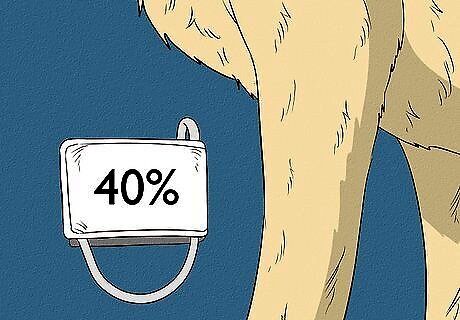
Check the size of the cuff. Before you perform the test, you'll need to make sure the blood pressure cuff fits your dog correctly. A cuff that is too large often produces falsely low blood pressure readings, while a cuff that's too small will yield a falsely high reading. The ideal size for a blood pressure cuff is approximately 40 percent of the dog's appendage circumference. Fold the cuff in half and wrap it around the pet's limb. A well-fitted cuff will measure 40% of the circumference of the lower leg (or slightly less than a cuff folded in half) in a dog and 30% of the circumference of the lower leg (or almost half of a cuff folded in half) in a cat.
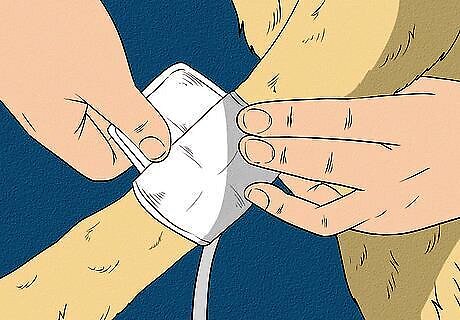
Attach the cuff. Once you've determined that the cuff is the correct size for your dog, you can attach the cuff and proceed in taking a measurement. The cuff should be snug and secure without being too tight. It should be just snug enough that you cannot insert a finger between the cuff and the dog's appendage.
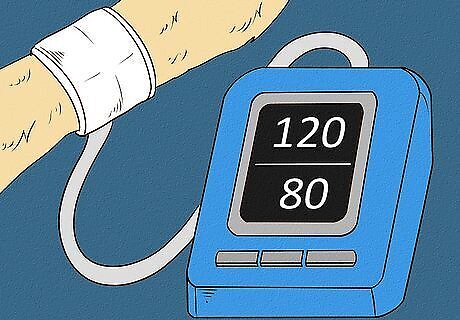
Inflate the cuff, then take a reading. Once the cuff is in place, the rest of the test is very similar to that of a human blood pressure measurement. You'll simply activate the automatic device, allow the cuff to inflate, then take the reading that the device gives you. The cuff presses against the dog's artery while inflated, and the pressure inside the cuff gets above the dog's systolic pressure. As the cuff deflates, the machine measures both systolic and diastolic blood pressure. Hold the cuff (attached to the dog's appendage) at chest level on the dog, which should be approximately the height of the dog's heart. The normal systolic blood pressure range is between 110 and 160 mm of mercury (Hg). Normal diastolic blood pressure lies between 60 and 90 mm Hg. A dog has high blood pressure if its systolic blood pressure is consistently above 180 mm Hg.
Checking Blood Pressure Using the Doppler Method

Choose a spot to take the measurement. Much like the automated device test, the doppler method requires you to choose a location to place the cuff. You can measure a dog's blood pressure on either front forearm.
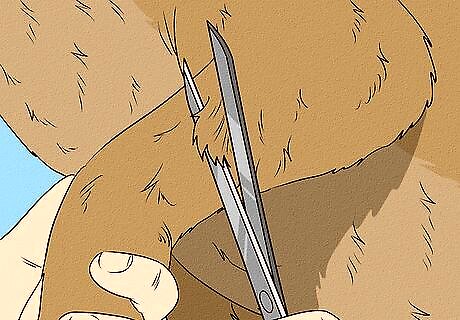
Trim the fur over the necessary sites. Whichever site you choose to take a measurement, you'll need to trim some of your dog's fur to get a more accurate reading. You shouldn't have to shave the fur, but you will need to carefully trim it down as short as you can safely get it without accidentally cutting your dog. If you're using the right front forearm, trim the fur over the palmar metacarpal artery (just above the joint that hinges and leads to the paw, or the equivalent of a wrist).
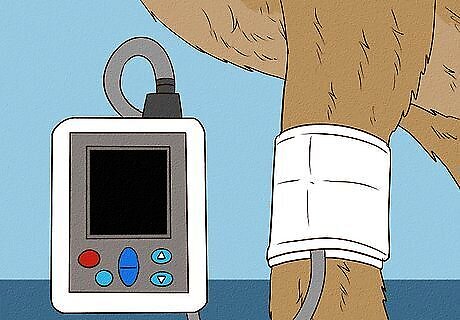
Attach the cuff and connect it to the device. Once you've trimmed the fur, you're ready to attach the cuff to your dog's appendage. The cuff should be attached snugly and in place around the chosen appendage. It should not be too tight, but it should be snug enough that you cannot slide a finger under the cuff. Connect the cuff to the sphygmomanometer to the cuff. Its base reading should show a pressure of 0 mm Hg.
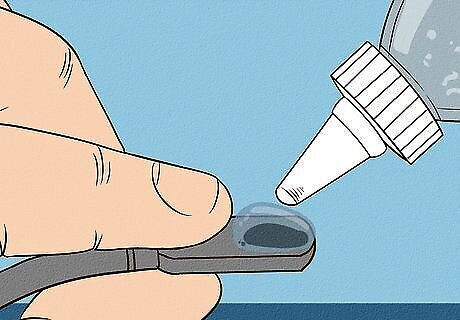
Apply acoustic gel to the Doppler probe. You will need to use acoustic gel with a Doppler probe. Acoustic gel is essentially the same gel used by doctors to perform an ultrasound. The acoustic gel should be applied to the concave side of the Doppler probe, as this is the surface that will be placed against the skin. Once the gel has been applied, press the probe firmly against the skin above the chosen artery.
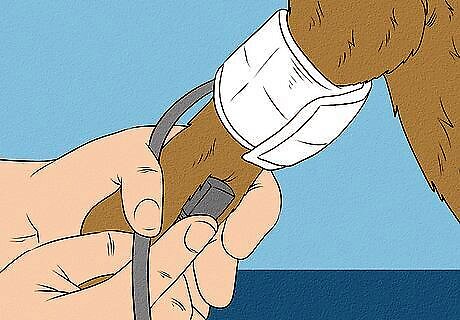
Inflate the cuff and take a reading. With the cuff and Doppler probe in place, you're ready to take a reading. The Doppler probe works by inflating the cuff until blood flow is restricted in your dog's artery, then measuring the pressure at which blood flow is audible again. The limb should be held approximately level with the dog's heart. This should be roughly at chest level if the dog is lying on its side. Inflate the cuff to about 20 mm Hg higher than the anticipated systolic blood pressure. You should not hear any whooshing sounds (arterial pulsations) at this pressure. Let the cuff slowly deflate and mark down the pressure at which you can hear the whooshing sounds again. This figure is the systolic arterial blood pressure.
Monitoring Your Dog for Health Problems
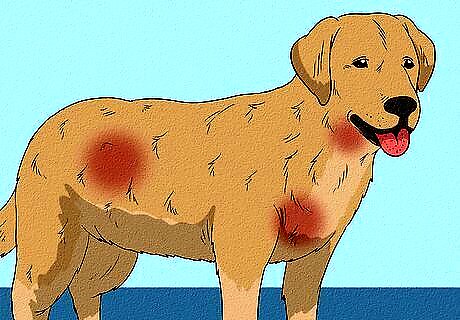
Learn about common underlying conditions. There are a number of conditions that could cause hypertension in dogs. Some, like obesity, can be treated with dietary and lifestyle changes. Others may require medication or even surgery to treat. Some common conditions that can cause high blood pressure include: Chronic renal disease Glomerular disease Endocrine disease Diabetes mellitus Acromegaly Adrenal tumor Polycythemia Obesity Heart disease Thyroid disease Stress Anxiety

Help your dog lose weight. Your dog's nutrition doesn't directly cause any health conditions that would lead to high blood pressure. However, a diet high in fat may cause your dog to become obese, which is a common cause of hypertension. Check the nutritional label on your dog's food and any treats you commonly give your pet. Look for foods that are low in fat. You may want to consider restricting your dog's sodium intake as well. Give your dog plenty of exercise. Take your dog for at least one 30-minute walk each day, but be sure to bring plenty of water for your pet.

Schedule follow-up visits with your vet. If your dog has been diagnosed with high blood pressure, you'll need to schedule regular checkups with your veterinarian. Your vet will need to monitor your dog's progress over time and may recommend further dietary changes or medication. Dogs with high blood pressure should have their blood pressure checked by a vet every few months. Your vet may recommend one or more medications, either to dilate the blood vessels (to lower your pet's blood pressure) or to treat the underlying condition causing hypertension. Which medication your vet recommends will depend on how high your pet's blood pressure is and what underlying condition(s) your dog has.




















Comments
0 comment